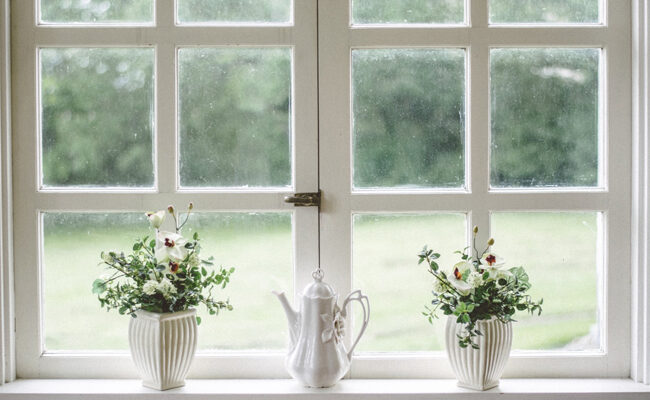
Windows are a vital part of your home, but they’re also something that many people take for granted.
Understanding the anatomy of a window is actually quite important in order for you to make sure that it functions the way it should.
Read on to learn more about different window parts so you’ll know exactly what each one does, and why they’re so crucial.
Exterior Double-Hung Window Anatomy
A double-hung window is one of the most common styles of windows you’ll find in today’s homes. These windows are typically crafted with either wood, fiberglass, or vinyl frames and they provide your home with outstanding airflow and ventilation.
This window style is made of two vertically sliding sashes that can be opened at the top or bottom to let more air inside. The frame is what surrounds the entire window and gives it support. Window frames are made of the head, jamb, and windowsill or sill.
The head of the window is the major horizontal section that forms the very top of the window frame. The jamb is similar, however, it’s the vertical parts or sides of the frame instead of the top.
A windowsill is the main horizontal section that forms the very bottom part of the window’s frame. A part called the jamb liner is a strip that goes on the sides of the frame to help it fit snugly into the sash.
Anatomy of a Window: Interior Parts
The inside or interior of your window is the area that you’ll see and use the most often. While these parts of a window are crucial for functionality, they also play a role in how your windows look from the inside.
The balance is a mechanical part that helps to counterbalance the weight of the sash when you close your windows. This part can be used in both single and double-hung windows.
You’ll probably hear window companies use the term sash when discussing windows. This part of your window is the moveable part that makes up the vertical and horizontal frame that holds the glass, and it’s probably the most common term you’ll hear, other than the glass itself.
Most windows have parts called rails, and each type of rail serves a different purpose. Double-hung windows have a check rail, which is where the bottom part of the upper sash and the upper part of the lower sash come together (AKA the middle of your window).
A rail is the horizontal piece of the sash and is made up of the lower rail, upper rail, and check rail. And, of course, the lower rail is used to define the lower part of the window sash and the upper rail is the top part of the upper window sash.
Casement Window Parts
There are many types of windows available, and a casement window operates a bit differently than single or double-hung styles. These windows are opened and closed using a hand crank to let air inside your home as it moves the window out and away from the frame.
The term aluminum-clad refers to the exterior parts of wood on a window that is covered with durable, factory-applied aluminum to protect the wood from the elements. Many windows contain argon, an inert gas that insulates your windows and reduces heat transfer to keep your home comfortable.
A lock handle is the locking mechanism found on the jamb of the window. Most window companies simply use the term lock, but the word handle is added if your window is a casement style.
Casement windows and other window styles use weatherstripping to help them stay insulated. This durable, flexible material covers the joint between the window sash and frame to keep water out and to reduce air leaks.
The window casing is the decorative molding around your windows. The casing is what covers the space between the frame and the wall to give the windows an attractive look.
More Window Terminology
A beautiful window requires a variety of pieces that all come together to make it look amazing. The term muntin refers to the grids of your window. These pieces are usually snapped into place directly over the glass, however, some muntins actually hold the window glass in place.
The term glazing refers to the glass in your frame and how it is installed. A single, double, or triple-glazed window consists of several pieces of glass with a bit of air in between each piece for optimum insulation.
A window apron is a horizontal board attached to the wall that is located underneath the windowsill. A stool is also referred to as the sill, and this is what sticks out from the bottom of your window like a shelf. The “stool” is typically on the inside, while the apron is usually on the outside of the home.
Get to Know Your Windows
Once you’re familiar with the anatomy of a window, you’ll have a better appreciation of how this important part of your home works. From the sill and sash to the jamb and rails, each piece of your window works in sync to help keep your home full of light and protected from the elements.
Learning about the different parts of a window will help you make repairs or choose new windows wisely.
For more great articles about interior design, gardening, furniture, and a whole lot more, be sure to visit our website today!
Leave a Reply